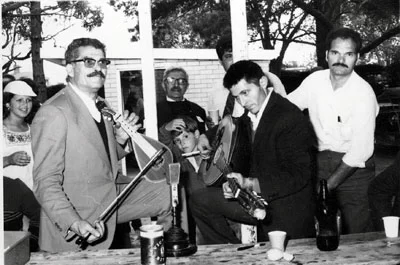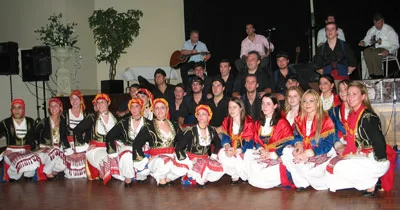History of the Cretan Community in Australia
The first gold was discovered in Australia in 1851 by Edward Hargraves at Bathurst in the state of New South Wales. Soon more than one thousand gold seekers descended there. Six months later more gold was discovered in Ballarat and Bendigo in the state of Victoria and within two years the population of Victoria increased from 77,000 to 540,000. More gold was discovered in the state of Queensland in 1853, in the Northern Territory in 1865, in the state of Tasmania in 1877 and in the state of Western Australia in 1890. These discoveries became known throughout the world with lightning speed. Thousands of gold seekers were arriving in Australia from all over the world and naturally also from Greece.
The first Greeks and amongst them many Cretans who started arriving in Australia in the middle of the 19th century were sailors from the Greek islands working on British vessels. On arriving in Australia they would jump ship and change their names, often anglicising them, not only to avoid government detection but also to overcome racial persecution.
Who was the first Cretan arriving in Australia before 1848 it is hard to say. Most probably he was one of the seven Greek convicts who were transported to Australia by the British and arrived on 27 August 1829. This was Giorgis Vasilakis but it is not known from which part of Crete he came from. The surname Vasilakis can be found throughout Crete but also in other parts of Greece were thousands of Cretans that had left Crete since the 1770 and later uprisings had escaped to. The seven Greeks that were arrested by the British and convicted on piracy were operating out of the fortress of Gramvousa on the northwestern tip of Crete. At that time Crete was suffering from the deprivations of the unsuccessful ten-year 1821 uprising and Cretans had taken over the fortress of Gramvousa to use as a base to seek supplies for the starving population as well as weapons and ammunition. This attracted pirates from nearby islands such as Hydra, Psara, Kasos and others who sought a safe base for their activities, thus making Gramvousa by 1827 the centre of piracy in the southwester Aegean. The British and French unhappy with this situation and with the agreement of the Greek government took action and suppressed this situation.
The seven convicts were eventually pardoned a few years later, with five of them leaving Australia while the other two remained.
The first recorded presence of a Cretan in Australia was that of Giorgis Dokos although which part of Crete he came from it is not known. Initially he was prospecting for gold in northwestern Victoria. In 1864 we find him in at Hill End in New South Wales looking for gold together with some other Greeks. At the age of 37 he married the daughter of a farmer in that area, Ellen O’Neill, at the local Anglican Church, with whom he had 8 children. He bought a farm and he settled into farming there where he eventually died of pneumonia in 1898 at the age of 69. The next recorded presence of a Cretan was that of Miltiades Mpitzanakis in Adelaide in 1861 from Palaia Roumata of the Chania prefecture. Then we find the brothers Costas and Nikolaos Vogiatzis from Tourloti Sitias in 1877 in Brisbane and 1888 in Sydney respectively. Also in 1877 in Sydney there was Stratis Androulakis from Apodoulou of the Amari area. They were followed by many more, especially in the early parts of the 20th century. It must be noted also that many Greeks that came from Kythera and other parts of Greece had Cretan ancestry, having left Crete during one of the many uprisings during the late 19th and early 20th centuries.
The largest influx of Cretans in Australia took place in the fifteen-year period of 1955-1970 so that by 1981 more than 7,000 Cretans had arrived in Australia. More than three quarters of them live in Melbourne where the majority of Greeks have settled in Australia. Melbourne is considered to be the city with the third largest Greek presence after Athens and Thessalonica. There are now about 500,000 people of Greek descent in Australia with about 10,000 of them of Cretan descent.

Cretans in Australia have an active social life aimed at maintaining and strengthening their ties with their motherland. The first formal association that was formed in Australia was the Cretan Brotherhood of Melbourne and Victoria in 1956. In March 1968 the Cretan Association of Victoria was established that later amalgamated with the Pancretan Brotherhood of Melbourne that was established in 1977. In November 1972 the Rethimnian Association of Melbourne “Arcadi” was established which continues to be today the largest association in Melbourne. Sydney has the second largest Cretan population in Australia. The first association that was formed in Sydney was the Pancretan Union in 1959 that was renamed later as Cretan Association of Sydney and New South Wales. Similar bodies were formed in Brisbane, Adelaide, Perth, Canberra, Hobart, Darwin and in New Zealand. In 1994 all these associations came under the auspices of the Cretan Federation of Australia and New Zealand.
Every year there is a three-day national conference with participation of members of the Associations from throughout Australia and New Zealand that focuses on maintaining and promoting the community’s ties with Greece and Crete. Every year there is also a commemoration of the Battle of Crete with participation of Australians and New Zealanders as well as representation of the Greek state and its military representatives. As a result of activities by those associations there are today two Greek – Australian monuments that have been built, one in Melbourne and one in Canberra, to symbolise the strong friendship links between the two peoples.

It is encouraging to see today that the second generation of young Cretans are taking over from their parents the responsibility and leadership for maintaining the Cretan tradition here in Australia and for strengthening the Cretan community’s ties with Greece and Crete.
Article by Socrates Tsourdalakis
Editor’s Note:
Mr. Socrates Tsourdalakis is from Melambes of the district of Agios Vasilios of the Rethimnos prefecture. He migrated to Australia in 1965 where he is currently finalising his book “The Cretans of Oceania from the 19th century to today”, a study that he has been researching and writing since his retirement from work in 1998. It is expected that the book will be published in May this year in Greek. Mr Tsourdalakis has been an active member of the Cretan community in Melbourne having been a founding member of the Rethimnian Association of Melbourne “Arkadi” since 1972 and has served as Secretary of the Association for 13 years until 1985.
This was amazing to come across, I am a descendant of Giorgis Dokos. I am visiting Crete because of him later this year, it’s just a shame I can’t find exactly which part of Crete he lived in, but thanks for this information anyway.
Jacqueline.